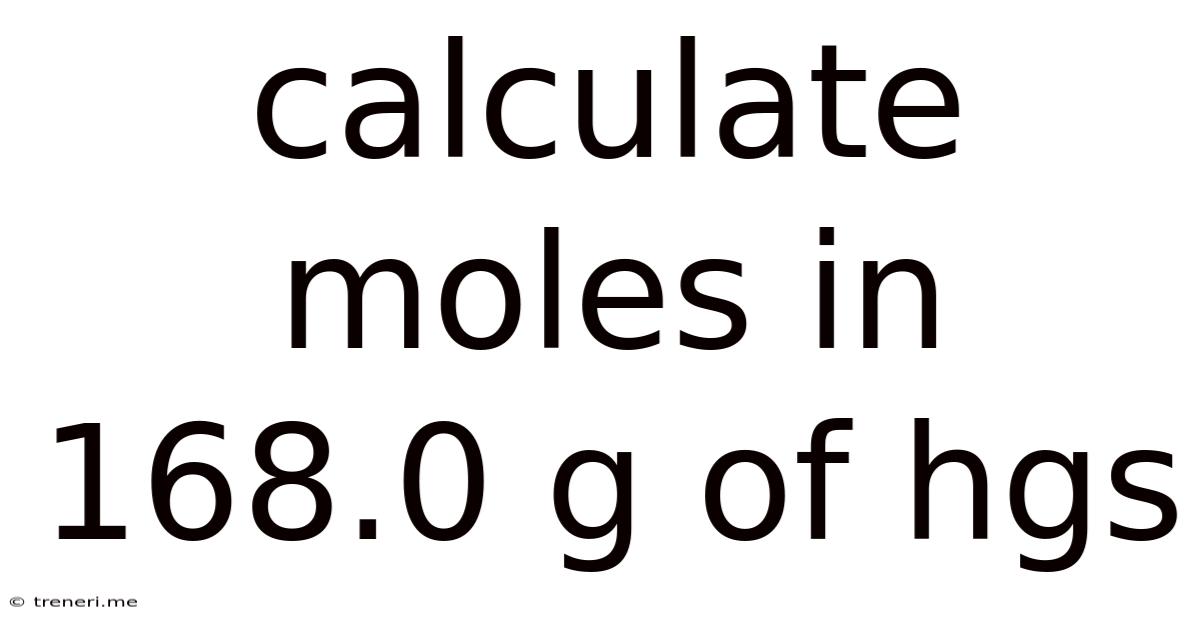Calculate Moles In 168.0 G Of Hgs
Treneri
May 11, 2025 · 4 min read

Table of Contents
Calculating Moles in 168.0 g of HgS: A Comprehensive Guide
Understanding molar mass and mole calculations is fundamental in chemistry. This article provides a detailed walkthrough of how to calculate the number of moles present in 168.0 g of mercury(II) sulfide (HgS), covering the underlying concepts and offering practical applications. We'll delve into the step-by-step process, discuss potential pitfalls, and explore related calculations to solidify your understanding.
Understanding Moles and Molar Mass
Before we embark on the calculation, let's refresh our understanding of key concepts:
What is a Mole?
A mole (mol) is a fundamental unit in chemistry, representing Avogadro's number (approximately 6.022 x 10<sup>23</sup>) of particles. These particles can be atoms, molecules, ions, or any other specified entity. Think of it as a convenient counting unit for incredibly large numbers of tiny particles. Just as a dozen represents 12 items, a mole represents 6.022 x 10<sup>23</sup> items.
What is Molar Mass?
Molar mass is the mass of one mole of a substance. It's expressed in grams per mole (g/mol). The molar mass of an element is numerically equal to its atomic weight (found on the periodic table) but with the units changed from atomic mass units (amu) to grams per mole (g/mol). For compounds, the molar mass is the sum of the molar masses of all the atoms in the chemical formula.
Calculating the Molar Mass of HgS
To calculate the number of moles in 168.0 g of HgS, we first need to determine the molar mass of HgS.
Atomic Weights from the Periodic Table
From the periodic table, we find the atomic weights:
- Mercury (Hg): Approximately 200.59 amu
- Sulfur (S): Approximately 32.07 amu
Calculating the Molar Mass of HgS
The chemical formula HgS indicates one mercury atom and one sulfur atom per molecule. Therefore, the molar mass of HgS is:
Molar Mass (HgS) = Molar Mass (Hg) + Molar Mass (S) = 200.59 g/mol + 32.07 g/mol = 232.66 g/mol
Calculating Moles in 168.0 g of HgS
Now that we have the molar mass of HgS, we can calculate the number of moles in 168.0 g. We'll use the following formula:
Number of moles (n) = Mass (m) / Molar Mass (M)
Where:
- n = number of moles
- m = mass of the substance (in grams)
- M = molar mass of the substance (in g/mol)
Plugging in the values:
n = 168.0 g / 232.66 g/mol = 0.722 moles
Therefore, there are approximately 0.722 moles of HgS in 168.0 g of HgS.
Significant Figures and Precision
It's crucial to pay attention to significant figures in your calculations. The given mass (168.0 g) has four significant figures. The molar mass we calculated (232.66 g/mol) also effectively has four significant figures (though the atomic weights used might have more). Therefore, our final answer should also have four significant figures, which is why we reported 0.722 moles rather than a more extended decimal representation.
Practical Applications and Further Calculations
Understanding mole calculations has widespread applications in various chemical contexts:
Stoichiometry
Stoichiometry involves using balanced chemical equations to determine the quantitative relationships between reactants and products in a chemical reaction. Knowing the number of moles allows you to calculate the amounts of other substances involved in the reaction. For example, if HgS reacts with oxygen, you could use the mole calculation to predict how much mercury oxide would be formed.
Solution Chemistry
In solution chemistry, molarity (moles of solute per liter of solution) is a crucial concentration unit. Being able to calculate moles is essential for preparing solutions of specific concentrations.
Gas Laws
The ideal gas law (PV = nRT) directly utilizes the number of moles (n) to relate the pressure (P), volume (V), temperature (T), and gas constant (R) of a gas.
Titration Calculations
Titration, a common analytical technique, relies on mole calculations to determine the concentration of an unknown solution.
Potential Pitfalls and Troubleshooting
While the calculation itself is straightforward, some common errors can occur:
- Incorrect Molar Mass Calculation: Double-check the atomic weights from the periodic table and ensure you've correctly added the molar masses of all the atoms in the compound.
- Unit Conversion Errors: Always ensure consistent units. Convert all masses to grams before performing the calculation.
- Significant Figures: Pay careful attention to significant figures throughout the calculation and in your final answer.
- Rounding Errors: Avoid premature rounding during intermediate steps. Keep extra digits in your calculator until the final answer, then round appropriately.
Conclusion
Calculating the number of moles in a given mass of a substance is a fundamental skill in chemistry. This article provided a comprehensive guide to calculating the number of moles in 168.0 g of HgS, emphasizing the importance of understanding molar mass, significant figures, and the applications of mole calculations in various chemical contexts. By mastering this skill, you'll be well-equipped to tackle more complex stoichiometric and solution chemistry problems. Remember to always double-check your work and pay close attention to details to avoid common errors. Practice is key to mastering these concepts.
Latest Posts
Latest Posts
-
How Do You Find The Height Of A Rectangular Prism
May 11, 2025
-
130 Libras En Kilos Cuanto Es
May 11, 2025
-
2 Oz Pasta Dry To Cooked
May 11, 2025
-
What Is The Lcm Of 4 8 And 10
May 11, 2025
-
How To Calculate Velocity After Collision
May 11, 2025
Related Post
Thank you for visiting our website which covers about Calculate Moles In 168.0 G Of Hgs . We hope the information provided has been useful to you. Feel free to contact us if you have any questions or need further assistance. See you next time and don't miss to bookmark.